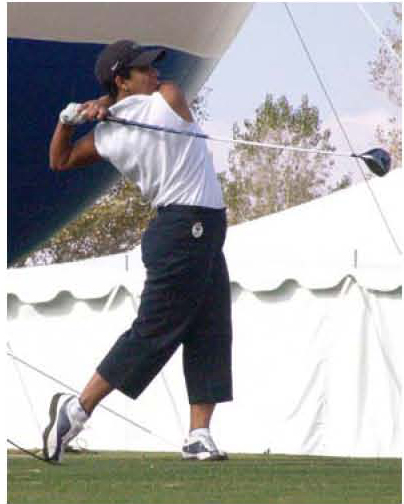
“All timing, distance and direction comes out of the lower body with the feet leading the way,” – Jack Nicklaus
Golf puts enormous demands on the body. Recognizing potential golfing injuries and planning ahead can prevent many injuries down the road. Problems with your feet, even a painful corn or callus, can impede your timing and balance.
During set-up, your weight should be evenly distributed on both feet with slightly more weight on the insides of the feet. At full address position imagine yourself rooted to the ground, strong and stable. A strong supported foot position during your setup is the foundation for a solid backswing.
Maintenance of proper foot alignment on the back swing is critical for control of the downswing and contact position. During the back swing, your weight should shift to the back foot and be maintained slightly on the inside. Any weight shift to the outside of your back foot may contribute to the “sway,” a common error in swing mechanics. As the back foot remains in a solid position on the back swing without any rolling to the outside, the front foot is in turn rolling to the inside. The front heel occasionally comes off the ground to promote a full shoulder turn. Completion of the back swing places the majority of your weight on the back foot, evenly distributed between forefoot and rear foot, with the weight left on the front foot rolling to the inside.
The downswing involves a rapid shift of weight from the back foot to the front foot; momentum brings the heel of the front foot down, and the follow-through naturally causes a rolling of the back foot to the inside and the front foot to the outside. Good foot action is the mark of an accomplished golfer.
Pain and stiffness in the lower back and neck are common golf injuries usually caused by the twisting motion of the golf swing as the shoulders rotate around the hips. The setup position also puts an incredible amount of pressure on the low back. Not surprisingly, the U.S. PGA cites lower back pain as its most common golf injury. One of the most common causes of lower back pain is over pronation (excessive rolling inwards) in the feet. Even a slight postural misalignment caused by over pronation can lead to back pain.
Foot pain among golfers is also common. Walking on uneven terrain, the rotational effect of the golf swing and miles of trekking all contribute to situations that can affect the feet. Common foot issues include plantar fasciitis (heel pain), arch pain, metatarsalgia (fore foot pain) and knee pain.
Orthotics allow a golfer’s body to establish a better point of contact with the ground when executing a golf swing. They will also stabilize your feet, evenly redistribute your weight and correct your entire body posture during the golf swing. Orthotics can help you improve your balance and therefore may help you hit the ball harder.
Orthotics can also prevent and treat a variety of painful injuries that can affect your concentration and ultimately your golf handicap. Bringing sore knees, legs, feet or an aching lower back to the fairway can prevent you from playing to the best of your golfing potential!
Wearing proper golf shoes is also critical to ensuring comfortable feet. Golf shoes are constructed using the basic principles of athletic footwear and the specific biomechanical principles of golf. Some even incorporate advanced technological innovations such as graphite shank reinforcements, which keep them light and add strength.
Fareen Samji is a certified Pedorthist with Milton Orthotic and Wellness Centre and Burlington Orthotic Centre, a former golf touring professional and has played on the Canadian Tour, Futures Tour, Asian Tour, South African Tour and in 2004 placed 12th in the World at the Remax World Long Drive Championships with a season’s best drive of 297 yards. Milton Orthotic & Wellness Centre carries Footjoy and Etonic golf shoes that come in wide widths and accommodate a custom foot orthotic nicely. Their knowledgeable staff will be able to assist you in selecting the best golf shoe for your foot type. Learn more at www.miltonorthoticwellness.com
Visit us at www.miltonOrthoticWellness.com
